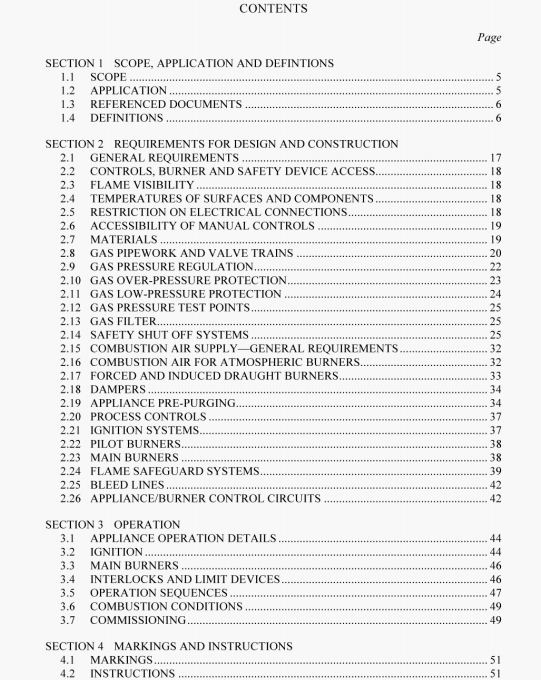AS 3814:2005 pdf – Industrial and commercial gas-fired appliances.
1.4.77 Natural draught
The flow produced by the tendency of warmed gases to rise.
1.4.78 Natural draught burner
See ‘Atmospheric burner’ under i3urner’.
1.4.79 Natural draught flue
See ‘Flue’.
1.4.80 Nominal gas consumption
The appliance gas consumption, in megajoules per hour. stated in specifications. data plates, instructions and general communications.
1.4.81 Non-return sake
A device designed to operate automatically to prevent reversal of how in a pipe.
1.4.82 Open flued appliance
An indoor appliance designed to be connected to an open flue system, its combustion air being dran from the room or space in which it is installed.
1.4.83 Operating pressure
The gas pressure that the consumer piping or the appliance is or will be subjected to under normal operating conditions.
1.4.84 Over-pressure protection system
A system preventing the pressure in piping or in an appliance from exceeding a predetermined value.
I .4.8 Over-temperature cut-out device
A manual reset or non-resetting device that functions to shut off the gas supply to a burner or burners to pre-vent temperature from exceeding a predetermined level.
1.4.86 Over-temperature limiting device
See Relief device’.
1.4.87 Part automatic burner
See ‘Burner’.
1.4.88 Permanent pilot
A pilot that is intended to he permanently alight while the appliance is in service and that is controlled independently of the main burner.
1.4.89 Pilot
A permanently located burner independent of the main burner, small in relation to it. and arranged to provide ignition for the main burner.
1.4.90 Position indicator switch
A switch that is activated when a particular position is reached.
1.4.91 Closed position indicator switch
A switch which indicates ‘closed’ when the valve is within 1 mm of the closed position or has reduced the flow to 10% or less of the equivalent fully open flow for a given pressure differential.
1.4.92 Open position indicator switch
A switch that indicates ‘open’ when the valve is ithin 10% of the fully open position.
1.4.94 Process after-burner
A gas-fired appliance used specifically tbr the incineration of exhaust gases containing combustible gases or dust in concentrations below the lower explosive limit.
1.4.95 Programmable electronic system (PES)
A system based on one or more central processing units (CPUs). connected to sensors andfor actuators, for the purpose of control, protection or monitoring.
NOTES:
I The term PES extends to and includes all elements in the system such as
(a) sensors and/or other input devices:
(b) data links and/or other communication paths: and
(c) actuators and/or other output devices.
2 The term PES includes system software such as executive, users and communication. etc. which is configured to operate a process.
3 The term PES is used to cover systems incorporating a wide range of programmable electronic devices and includes systems incorporating—
(a) microprocessors:
(b) programmable controllers (PCs);
(C) programmable logic controlkrs (PLCs);
(d) programmable state controllers:
(e) other computer based devices.
4 A PES can include a microprocessor-based temperature. pressure, air/fuel ratio, or level controller or monitor.
1.4.96 Programming flame safeguard
A flame safeguard that automatically sequences at least two burner functions such as ignition spark, gas valve, etc.
AS 3814:2005 pdf – Industrial and commercial gas-fired appliances
